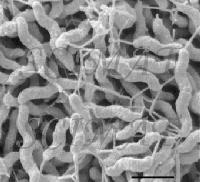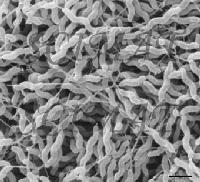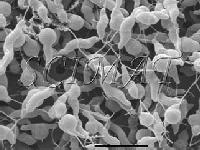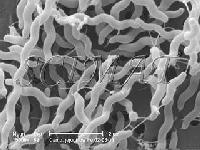C. jejuni is the leading cause of bacterial diarrhea in the United States and in Britain. It is frequently found in raw chickens. Contaminated water, infected pets and unpasteurized milk also are sources of these bacteria. Campylobacter species are among the most common pathogens in humans and are commensal in birds, swine, and cattle. Virtually all persons infected with Campylobacter recover without any specific treatment. Some long-term consequences can, however, result from a Campylobacter infection. It is possible to take precaution and avoid infection.
The SEM images of C. jejuni shown above were obtained using bacterial cultures provided in 2006 by Ms. Marina Steele, M.Sc., at that time at the University of Guelph, Ontario, Canada. Several media (both solid and liquid) could be used to grow these bacteria. Those shown in Figures 1 and 2 were grown in Brucella Broth under microaerophilic conditions (5% oxygen, 10% carbon dioxide, and 85% nitrogen) at 37°C on a shaker. The spiral-shaped C. jejuni in the micrographs are representative of healthy log-phase cells.
When the bacteria are stressed, they develop a coccoidal morphology as shown in Fig. 3. In this case, the bacteria were first grown at 37°C with shaking at ~100 rpm in MEM Alpha medium supplemented with 5 micromolar ferrous sulfate. The same microaerophilic atmosphere was used as mentioned above. Stressing was accomplished by exposing the bacteria to aerobic atmosphere for 2 days at 20°C. The cells contain a large proportion of cells that are round as opposed to spiral.
Campylobacter jejuni grown in conditions of nutrient limitation, such as low iron levels, may form very long spiral-shaped cells (Fig. 4). The growth conditions were the same as previously but ferrous sulfate was left out of the medium.
For access to images of other microorganisms please visit the home page.
Home
|







